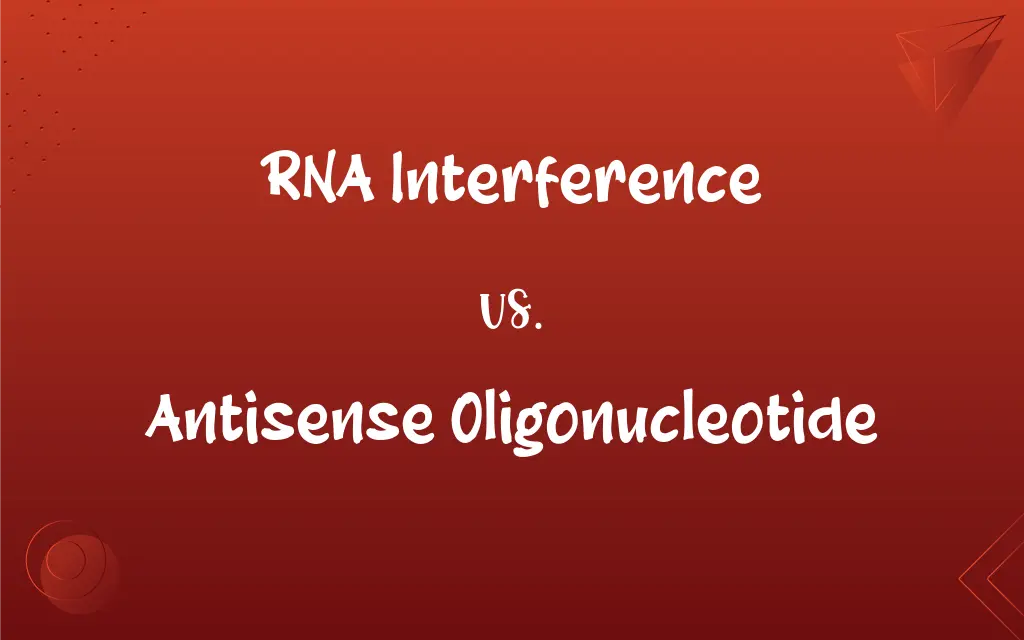RNA Interference vs. Antisense Oligonucleotide: What's the Difference?
Edited by Aimie Carlson || By Janet White || Published on February 25, 2024
RNAi is a cellular process that silences gene expression by destroying or blocking specific mRNA molecules. ASO is short, synthetic strand of DNA that binds to specific mRNA sequences to inhibit gene expression.

Key Differences
RNA interference (RNAi) and antisense oligonucleotides (ASOs) are both molecular techniques used to regulate gene expression, but they operate through distinct mechanisms. RNAi involves the use of small RNA molecules, such as small interfering RNA (siRNA) or microRNA (miRNA), which target specific messenger RNA (mRNA) molecules for degradation, thus preventing the production of specific proteins. In contrast, ASOs are short, synthetic strands of DNA or RNA that bind to mRNA, but they can either block the mRNA from being translated into protein or trigger its degradation through different pathways.
RNAi is a naturally occurring process in cells, ASOs are synthetic constructs designed in laboratories. RNAi typically uses molecules that are part of the cell's natural machinery to regulate gene expression and can be harnessed to silence genes in a more general manner. ASOs, on the other hand, are specifically engineered to complement the sequence of a particular mRNA, allowing for targeted gene silencing with potentially greater specificity. This difference in origin—natural for RNAi and synthetic for ASOs—also reflects in their applications and development in therapeutic contexts.
The delivery mechanisms for RNAi and ASOs also differ. For RNAi, siRNAs or miRNAs need to be introduced into the cell and incorporated into the RNA-induced silencing complex (RISC) to guide the complex to the target mRNA. ASOs are designed to be more stable within biological environments and can be modified to enhance their delivery and binding affinity to the target mRNA. These modifications can include chemical alterations to the ASO structure that improve its stability and efficiency.
In terms of therapeutic applications, both RNAi and ASOs hold promise, but their pathways to clinical use are different. RNAi's natural occurrence in cells makes it a compelling tool for gene silencing, with potential applications in treating viral infections, cancers, and genetic disorders. ASOs, being synthetic, have been more rapidly adapted to clinical applications, such as in the treatment of spinal muscular atrophy and certain metabolic disorders. Their synthetic nature allows for precise design and optimization for specific targets, which is crucial in therapeutic settings.
The safety profiles and potential off-target effects of RNAi and ASOs are areas of ongoing research. RNAi, while powerful, can sometimes lead to unintended gene silencing due to partial complementarity with off-target mRNAs. ASOs, though designed for specificity, can still interact with unintended targets or elicit immune responses. Both technologies are continually being refined to maximize their efficacy and minimize adverse effects, making them increasingly valuable tools in both research and medicine.
ADVERTISEMENT
Comparison Chart
Nature
Natural cellular process
Synthetic DNA or RNA fragments
Mechanism
Utilizes siRNAs/miRNAs to degrade mRNA
Binds to mRNA to prevent translation or degradation
Specificity
Sequence complementarity
Sequence complementarity and chemical modifications
Role in Research/Therapy
Gene knockdown, gene regulation studies
Disease treatment, gene expression studies
Chemical Stability
Naturally occurring, less stable
Chemically modified for enhanced stability
ADVERTISEMENT
RNA Interference and Antisense Oligonucleotide Definitions
RNA Interference
RNAi is a biological process where RNA molecules inhibit gene expression.
In the lab, we used RNA interference to silence the gene responsible for the disease.
Antisense Oligonucleotide
Antisense oligonucleotides are used in genetic research and therapy.
In our genetic therapy trial, an antisense oligonucleotide was key in treating the genetic disorder.
RNA Interference
RNAi is a cellular defense mechanism against viral infections.
RNA interference played a key role in protecting the cells from the viral RNA.
Antisense Oligonucleotide
ASOs can induce RNase H activity to degrade target mRNA.
The antisense oligonucleotide triggered RNase H, which then cleaved the disease-causing mRNA.
RNA Interference
RNAi is a gene silencing mechanism mediated by siRNA or miRNA.
The introduction of siRNA triggered RNA interference, effectively silencing the problematic gene.
Antisense Oligonucleotide
Antisense oligonucleotides modulate gene expression by hybridizing with specific mRNA.
We used an antisense oligonucleotide to decrease the production of the harmful protein.
RNA Interference
RNA interference involves small RNAs that target and degrade specific mRNA molecules.
Scientists often use RNA interference to study gene function by knocking down specific genes.
Antisense Oligonucleotide
ASOs can correct mRNA splicing in genetic diseases.
The antisense oligonucleotide corrected the splicing error, restoring normal protein function.
RNA Interference
RNA interference regulates gene expression at the post-transcriptional level.
Through RNA interference, we managed to control the overexpression of the target gene.
Antisense Oligonucleotide
ASOs are synthetic DNA or RNA molecules that bind to and inactivate mRNA.
The antisense oligonucleotide effectively targeted the mutant mRNA, reducing the disease symptoms.
FAQs
What's the role of siRNA in RNA interference?
siRNA guides the RNA-induced silencing complex to the target mRNA for degradation in RNA interference.
What is RNA interference?
RNA interference is a natural process where small RNA molecules inhibit gene expression by targeting specific mRNA.
How do antisense oligonucleotides work?
Antisense oligonucleotides bind to specific mRNA sequences, blocking translation or triggering degradation.
Can antisense oligonucleotides target any gene?
ASOs can target most genes but require precise design for specificity and efficacy.
How long do antisense oligonucleotides remain active in the body?
The duration varies, but chemically modified ASOs can remain active for weeks to months.
Are antisense oligonucleotides safe for medical use?
ASOs are generally considered safe but require extensive testing for each specific application.
What is the difference between siRNA and miRNA in RNAi?
siRNA is often exogenously introduced for specific targeting, while miRNA is endogenous and regulates gene expression broadly.
Can RNA interference be used in therapy?
Yes, RNAi has potential therapeutic applications, such as in gene silencing to treat diseases.
What are the limitations of RNAi-based therapies?
RNAi therapies face challenges in delivery, specificity, and off-target effects.
How are antisense oligonucleotides delivered to cells?
ASOs are typically delivered into cells via nanoparticles, liposomes, or viral vectors.
Can antisense oligonucleotides treat neurological disorders?
Yes, ASOs are being explored for treating neurological disorders like spinal muscular atrophy.
Can RNA interference be used in agriculture?
Yes, RNAi is used in agriculture to develop disease-resistant crops and control pests.
How are antisense oligonucleotides evolving in medical research?
ASOs are evolving with better delivery methods and designs for increased specificity and reduced side effects.
What diseases can be treated with RNAi therapy?
RNAi therapy can potentially treat various genetic disorders, cancers, and viral infections.
Is RNA interference a permanent change?
No, RNAi induces a temporary reduction in gene expression.
Are there any side effects of antisense oligonucleotide therapy?
Side effects depend on the specific ASO and its target but can include immune responses and off-target effects.
Do antisense oligonucleotides affect DNA?
No, ASOs target mRNA and do not directly interact with DNA.
How is RNA interference used in research?
RNAi is used in research to study gene function by silencing specific genes.
What makes antisense oligonucleotides specific to their target?
The specificity of ASOs comes from their complementary base pairing with the target mRNA.
Can RNA interference target multiple genes at once?
Yes, RNAi can target multiple genes if designed with multiple siRNAs or miRNAs.
About Author
Written by
Janet WhiteJanet White has been an esteemed writer and blogger for Difference Wiki. Holding a Master's degree in Science and Medical Journalism from the prestigious Boston University, she has consistently demonstrated her expertise and passion for her field. When she's not immersed in her work, Janet relishes her time exercising, delving into a good book, and cherishing moments with friends and family.
Edited by
Aimie CarlsonAimie Carlson, holding a master's degree in English literature, is a fervent English language enthusiast. She lends her writing talents to Difference Wiki, a prominent website that specializes in comparisons, offering readers insightful analyses that both captivate and inform.































































